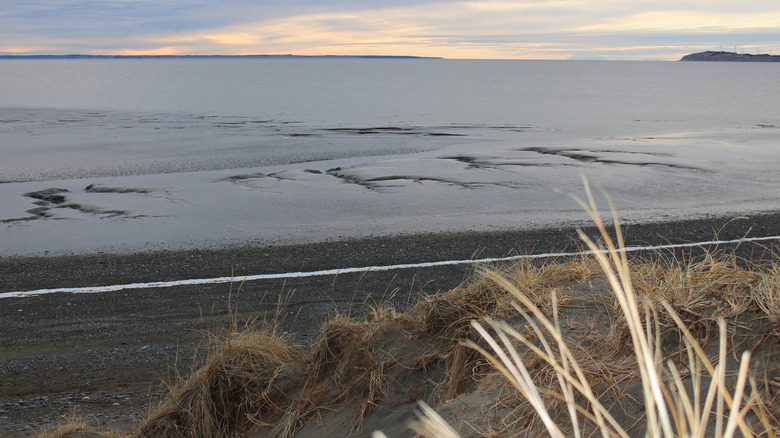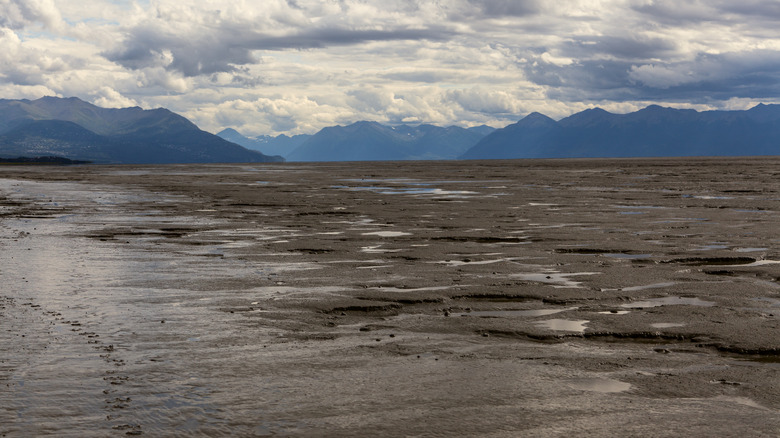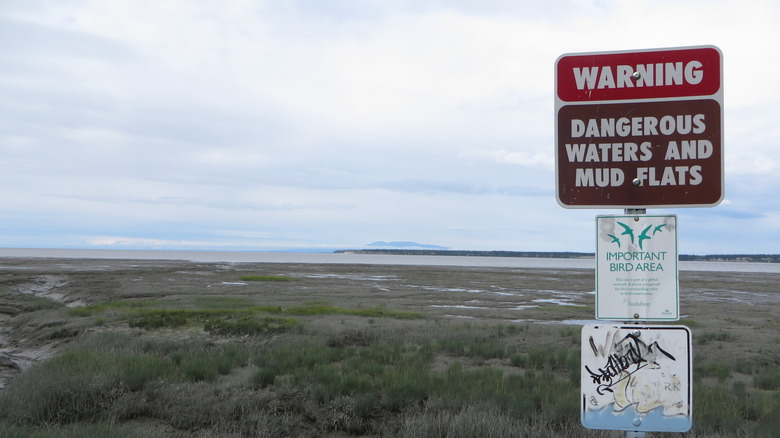The Horrifying Reason To Avoid Taking A Walk On Anchorage's Iconic Kincaid Beach
Perhaps you remember the iconic quicksand scenes from 1987's "The Princess Bride" and 1984's "The Neverending Story" — any child who watched these was forever terrified of swamps, quicksand, and thick, muddy waters thereafter. Although the movies were pure fantasy, the danger of those deadly encounters is very much grounded in reality — and you can find it in Alaska's Kincaid Park. This sprawling 1,500-acre expanse in Anchorage offers endless outdoor adventures, from hiking and biking to skiing and wildlife viewing. Within this park is Kincaid Beach, a sandy shore that promises tranquility and beauty. However, beneath the surface of this idyllic setting lies a true and horrifying urban legend that should make any potential visitor think twice before taking a walk on its sands.
@ilma.v Alaska things #alaska #anchorage #mudflats #quicksand #mud #nature #alaskathings
With its sweeping views of Cook Inlet and the distant peaks of the Alaska Mountain Range, Kincaid Beach appears to be a serene escape into nature, where many come to have bonfires at night and play in the sand during the day. Yet, just beyond this seemingly serene, sandy shoreline is a deadly threat that has claimed the lives of unsuspecting adventurers: the infamous Kincaid Beach mudflats. At first glance, they look like ordinary stretches of wet sand, but these mudflats are composed of a unique, glacial, silty mud with a consistency akin to quicksand. When the tide recedes, it leaves behind vast expanses of mud that stretch beyond the inlet. While they seem easily walkable and tempting to explore, the mudflats are a deceptive, risky trap.
Danger lurking in the sands and unforgiving tides
The tides in Cook Inlet are among the highest in the world, with the water level changing as much as 40 feet between high and low tide. This dramatic shift occurs with alarming speed, transforming the seemingly solid mudflats into a death trap in minutes. Visitors who venture too far onto the flats — usually to explore Fire Island, a large forested island in the Cook Inlet — find themselves mired in the mud, unable to get free as the tide rushes in. The waters are cold: The warmest temperatures are in August at 52 degrees, and the coldest are in February at 35 degrees. Only the bravest of souls — conditioned by cold plunges, perhaps — can brave Kincaid Beach, one of the most dangerous places to swim.
The water is also completely opaque due to the high silt content, which washes down from the glaciers, permanently coloring it a menacingly dark grey-blue shade. The silt composition of the mudflats is ever-changing: At one moment, it can be as hard as concrete, and the next, it can transform into a soft, liquified waterbed. In many cases, individuals become trapped in the mud up to their knees or even their chest. The more they struggle, the deeper they sink. As the tide surges back in, the water can rise alarmingly fast, leaving little time for rescue efforts. During the Bore Tide phenomenon, the rushing tide can bring very high waves, up to 10 feet tall.
Tragic cases and safety measures at Kincaid Beach
The tragic cases at Kincaid Beach will chill you to the bone. In 1961, a helicopter rescue mission failed as they tried to pull out Roger Cashin, a soldier from Fort Richardson who was stuck in the mud. He drowned as the rescue rope snapped. In 1988, 18-year-old Adeana Dickison fell victim to the icy water as her foot got stuck in dense mud. In 2013, Army Captain Joseph Hugh Eros didn't return to shore in time as the tide rushed over.
Given the lethal potential of Kincaid Beach's mudflats, it's crucial for visitors to be aware of the risks and take appropriate precautions. If it isn't clear by now, the most effective way to avoid this danger is to stay clear of the mudflats entirely. Admire their haunting beauty from a safe distance and resist the temptation to venture onto them, no matter how solid they might appear.
If you plan to visit the beach, check the tide schedules. The highs and lows follow a predictable pattern, and understanding it can help you avoid grave trouble. Pay attention to any warning signs or advisories posted in the area. Regardless of the tide or your wilderness experience, always go with a companion. Better yet, explore other areas of Kincaid Park and Anchorage, a must-see place for first-time visitors to Alaska. Even if you like long walks on the beach, taking a long walk on this one is something you should never do.


